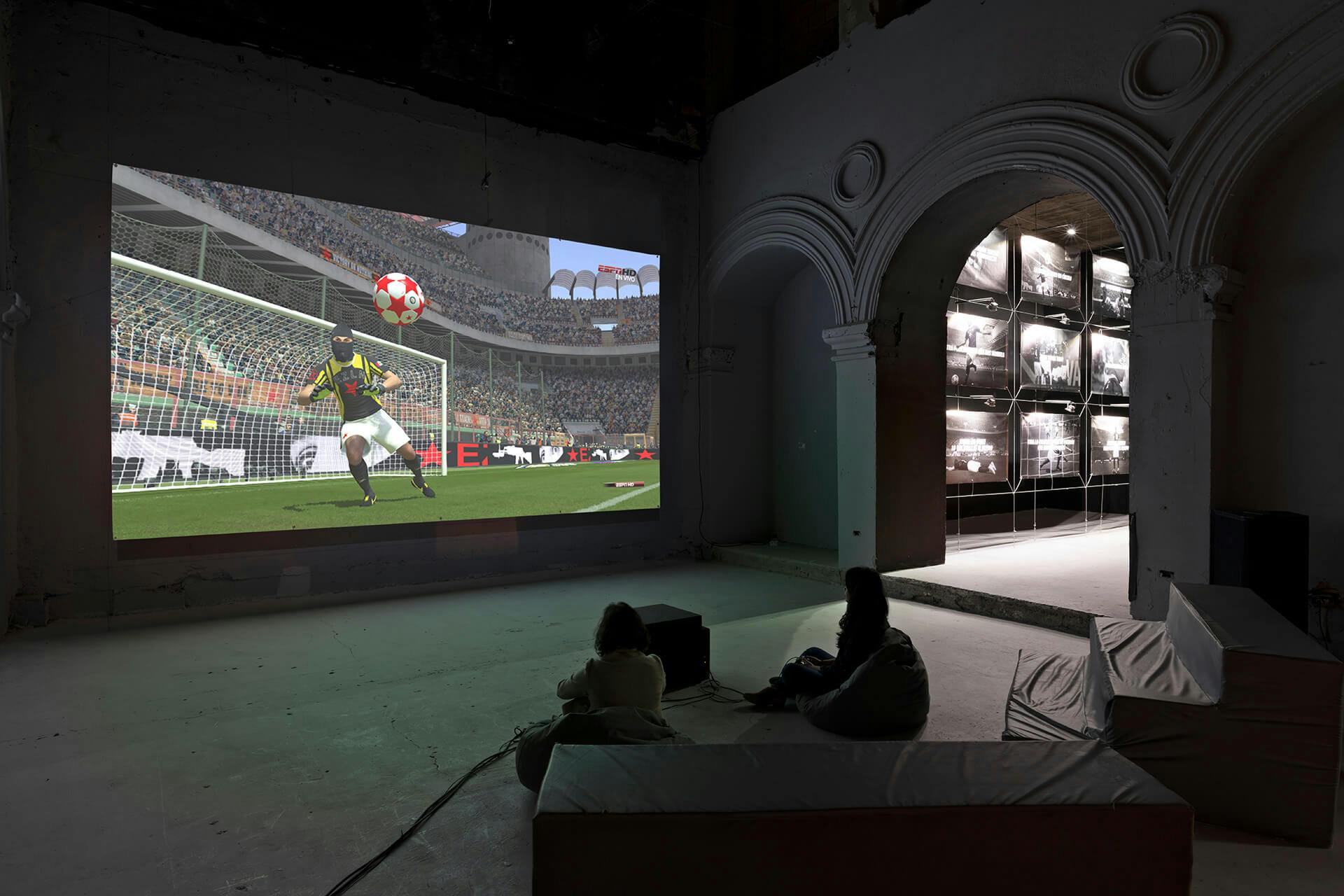Digital media artist Juan Obando utilizes public domain internet content as the primary medium in his work. “It’s as common as using the color blue,” he says of his materialization of everyday visual culture. Popular software and methods for digital communication—such as video games, dating apps, emojis, and music streaming—are re-networked in Obando’s work to create alternative spaces, actions, and objects that take once-digital norms into the physical. They don’t seem so normal in real life. Rather, Obando’s work twists the medium, creating the need for physical participation that is highly self-aware, and scrutinizes customary online interaction—with others and with the internet itself.
With Detroit-based, independent curator Isabella Achenbach, Obando discusses his practice as an alternative to the popular interest in public art as an exercise in common good.
This interview was originally published in Boston Art Review Magazine, Issue 04: The Public Art Issue in Fall 2019. This week, Boston’s newest contemporary art museum, the Mass Art Art Museum (MAAM) will open its doors to the public with three inaugural exhibitions. Juan Obando’s “Pro Revolution Soccer” will be on view as a playable work of art in “Game Changers: Video Games & Contemporary Art” from February 22nd through April 19th.
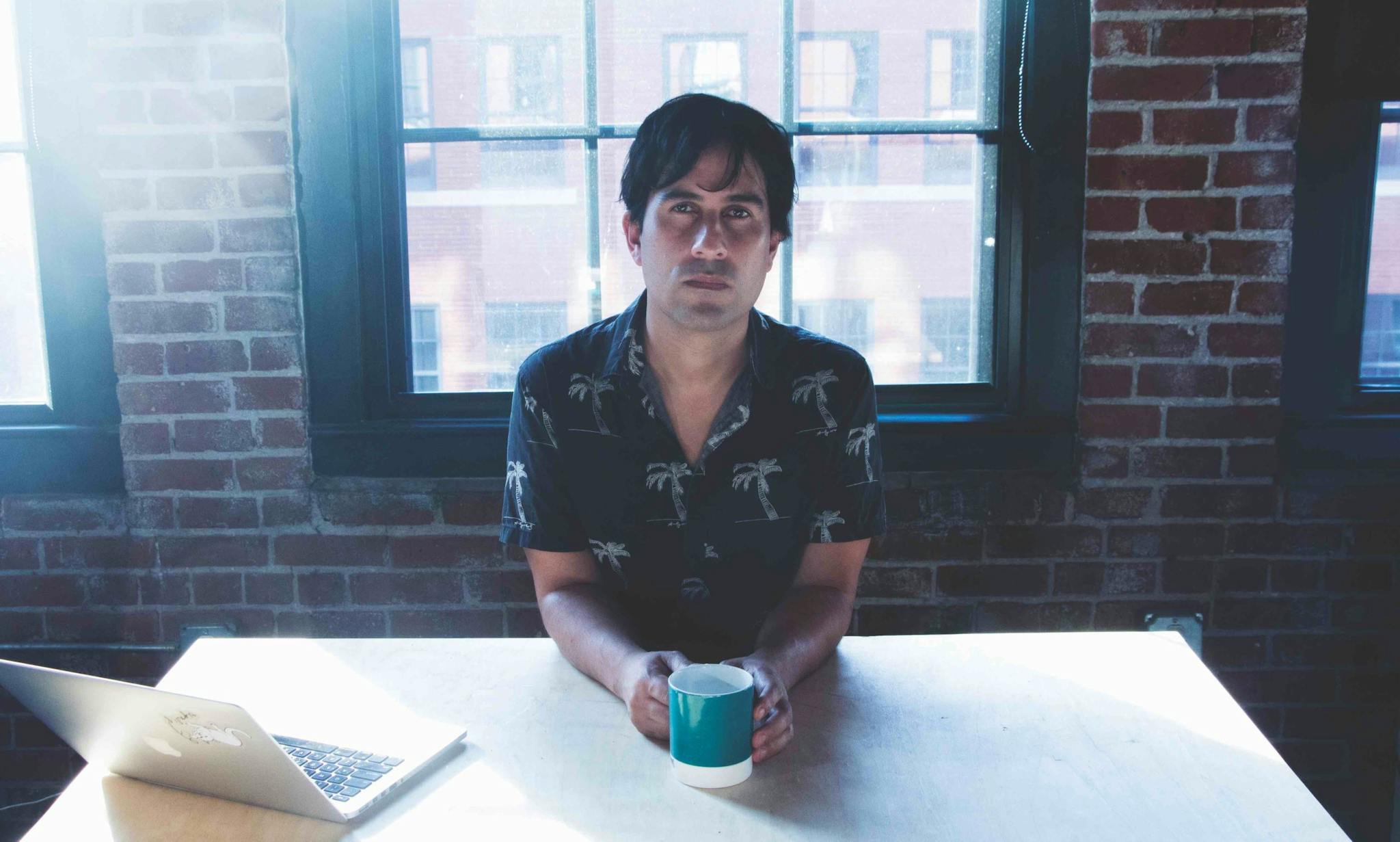
Juan Obando, Studio, 2019. Photo courtesy of artist.
Isabella Achenbach: We are having this phone call between Detroit and Bogotá, granting access to an app that uses a third-party phone number to record our conversation for the sake of our interview transcription—do you think we’re permanently bugged from here on out?
Juan Obando: Completely.
IA: All sense of privacy out the window!
JO: That’s a good disclaimer…
IA: Your work often exists in digital realms, but I’m curious how you would describe your practice. Is “public art” a term that you would ever even use for it?
JO: I wouldn’t specifically use “public art” or “public practice” to describe my work, but I am interested in the idea of the public domain. At a young age I started experimenting with exercises of intervention and appropriation, and slowly realized our common built environment—from the Internet to copyrighted material, political speeches, and popular culture—possesses a high potential for manipulation. If you look at the technologies that are publicly available today to mine our data, transform reality, and broadcast and distribute these distortions, you immediately start questioning what is real, what could be private, and what could be public on a global scale.
IA: You live and work in Boston but grew up in Bogotá and still spend about half of your time there, so I’d love to think about location and your work in a global context, especially since you’re working with the Internet and frequently cross-referencing American and Colombian culture.
JO: I think that in a way I appreciate the unruliness of a country like Colombia—where from the top down there is shameless corruption—in contrast to the highly regulated idea of public life in the US, which, in turn, hides a type of passive corruption that is mostly invisible. These local conditions [in Colombia] configure an environment in which public space is sometimes highly regulated and policed, and then you also see private spaces that are abandoned or unsupervised. This increases the gray areas in which there is no exact definition of what could be private or public, which is very inspiring to me.
IA: A real-life dark web.
JO: Yes, totally.
IA: At your most recent solo exhibition in Bogotá, “Pro Revolution,” you staged a fake Pussy Riot concert. We’ve spoken a little bit about the reaction to that concert and especially the kind of hysteria that it created from an Instagram-obsessed crowd. Going back to my previous question, do you think the effect of location, regional politics, and social norms were particularly apparent at the performance?
JO: That piece is rooted in a very particular incident from 2018 where Pussy Riot was supposed to perform at a huge public festival. After what the public considered a disappointing performance, some fans went to Pussy Riot’s official social media channels and discovered that there was no mention of the Bogotá show and that same night they were photographed performing in Edinburgh with “original” members. When the Colombian fans angrily denounced this, the Pussy Riot Facebook page responded with “Anyone Can Be Pussy Riot,” stating that both events were part of their official brand and that they were looking forward to having doubles in every city in the world. Analyzing this situation from my perspective in the United States, I couldn’t help but think about the implications of having this revolutionary brand become an international phenomenon, and the type of messaging that comes with that. It made me think about the ways in which U.S. interventionism has used (and helped create) international artists and revolutionary figures that align well with its own interests.
IA: The power of propaganda…
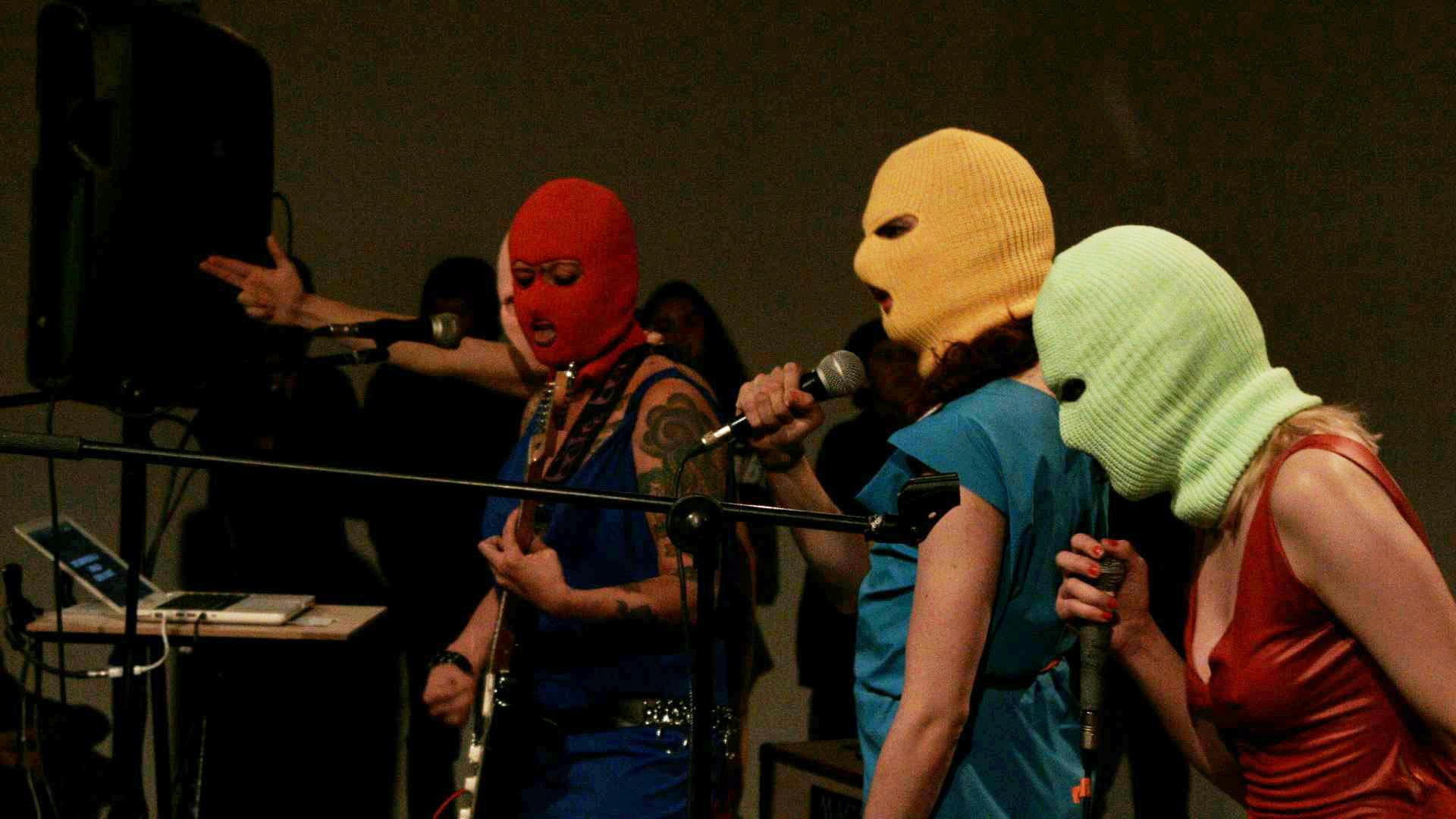
Juan Obando, PR, performance view, Espacio Odeón, 2019. Photo by David Escobar.
JO: It was so perfect that this incident happened in Colombia, as an example of our current communal simulative fiction at work. So when I organized a free “Pussy Riot” concert for my latest show in Bogotá at Espacio Odeón, I was not surprised that a lot of people really went for it. Again. The concert was announced as an independent event that had nothing to do with the exhibition, and I worked with a band from Medellín to co-write and pre-record the songs. These spoke directly, in Spanish and with some humor, about Pussy Riot’s own links to U.S. imperialist practices, the role of the CIA in art history, fake news, and so on. The concert was performed by four actors who lip-synced the songs in direct playback with the studio recording. They didn’t even play or sing.
My piece was not necessarily about Pussy Riot, but I used the incident as a way to structure a public situation where people could reflect on our global ingestion of fake news and propaganda. What would have happened if I had done this piece in Boston? I don’t know. I think in the United States there’s a bit more awareness about post-production methods, retouching and messaging, while in Colombia we are still in the very infancy of fake news, even though it operates widely there, in a very rudimentary but intense fashion.
That said, we all want to see what we believe.
IA: And it’s easy to be deceived by the beliefs of our friends and neighbors—it’s that crowd mentality. “PR” [the “Pussy Riot” concert] was made in tandem with a video game called “Pro Revolution Soccer;” can you talk about the politics involved in that program, which similarly utilizes the symbol of the “masked revolutionary”?
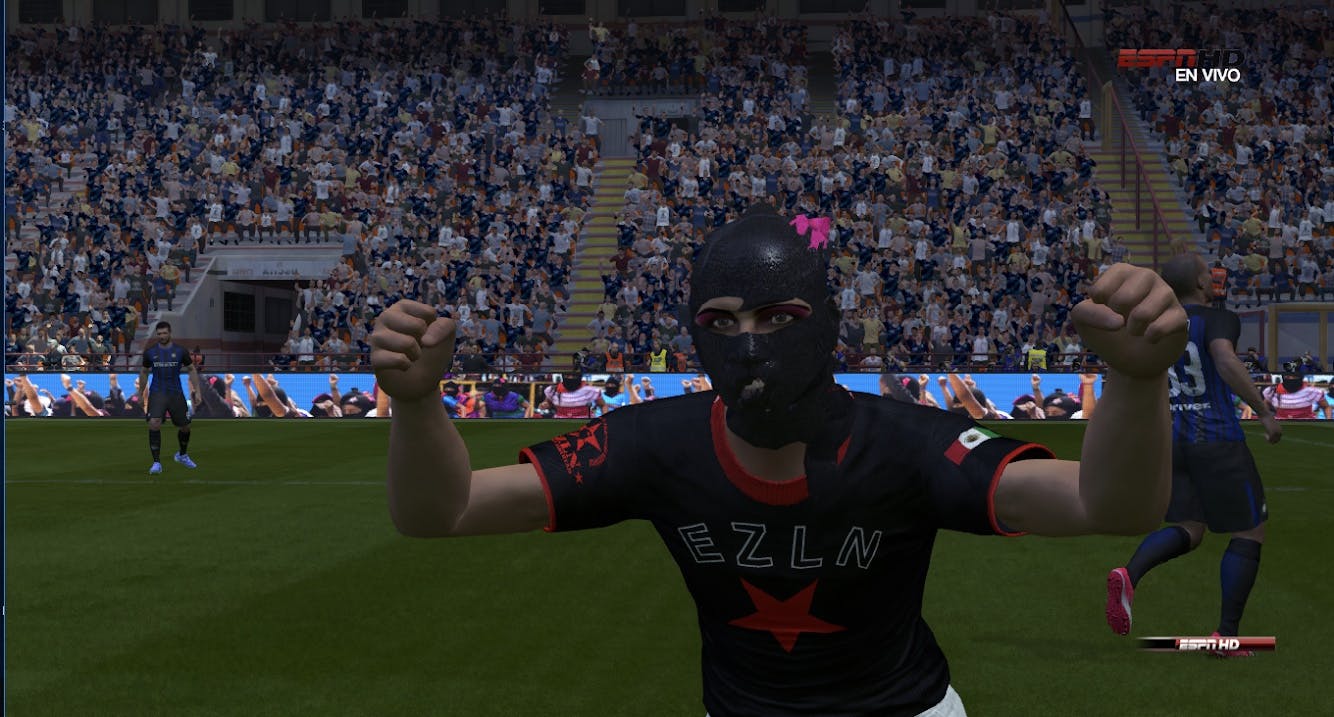
Juan Obando, Pro Revolution Soccer, video game stills, 2019. Courtesy of artist’s archive.

JO: “Pro Revolution Soccer” is a video-game installation inspired by the ongoing relationship between the Italian soccer club Inter Milan and the Zapatista Army of National Liberation (EZLN) in Chiapas, Mexico. Inter has sponsored EZLN since around 2004 and in 2005 EZLN challenged Inter to a soccer match that never materialized. Inspired by the culture of video-game hacking and piracy in Colombia, I modded [modified] the popular Pro Evolution Soccer game by Konami to present EZLN as one of the two teams, playing in balaclavas, reimagining the possibility of that legendary match as an interactive piece. Through this, I wanted to use contemporary hacking as a metaphor for the type of parasitic intervention that EZLN performs within the Mexican state system. In both cases, the intervention feeds on a system modeled by global capital in order to perform an autonomous zone that rejects the mechanics of capitalism.
IA: So the video game, as it’s linked to consumer culture and consumption, becomes reflective of the money laundering involved between political groups and international soccer teams?
JO: Not necessarily. With this piece I’m interested in using the EZLN story and the subculture of video game hacking in Colombia to present a counter-narrative to the historical crisis of revolutions that are defined by the takeover of a system, and to hopefully inspire a reading on alternative forms of dissent and intervention. In a sort of parasitic relationship, EZLN takes sponsorship and support from global figures that are integral parts of capitalism (like Inter Milan) but, with their political agenda, they also actively reject the introduction of capitalism into their community. They have created a capitalism-free zone supported, in some ways, by capitalistic actors.
IA: Is your intention that the gamer partake in “Pro Revolution Soccer” unaware of the political implications, or is the point that they have a charged connection to their fictional gamer characters, with an understanding of the historical and social context?
JO: As with the rest of my work, “Pro Revolution Soccer” is activated by the general situation that is staged within an art context. Even if the final forms of some of my works—karaoke machines, apps, video games, etc.—are directly extracted from mass media or commercial culture, they’re not conceived for casual consumption. In fact, they are highly dependent on the politics of the exhibition space, which I think comment on the very unique power of art.
IA: This idea of “the assumptions of the art experience” is especially spotlighted in your 2015 work “Jeep VIP,” which similarly demonstrates how you address social capitalism with both humor and sharp criticism. Can you talk a bit about this project and the way it links the general public and a more exclusive art market/art world scene?

Juan Obando, Jeep VIP, performance views, MDE15, Medellín, Colombia, 2015. Courtesy of artist’s archive.
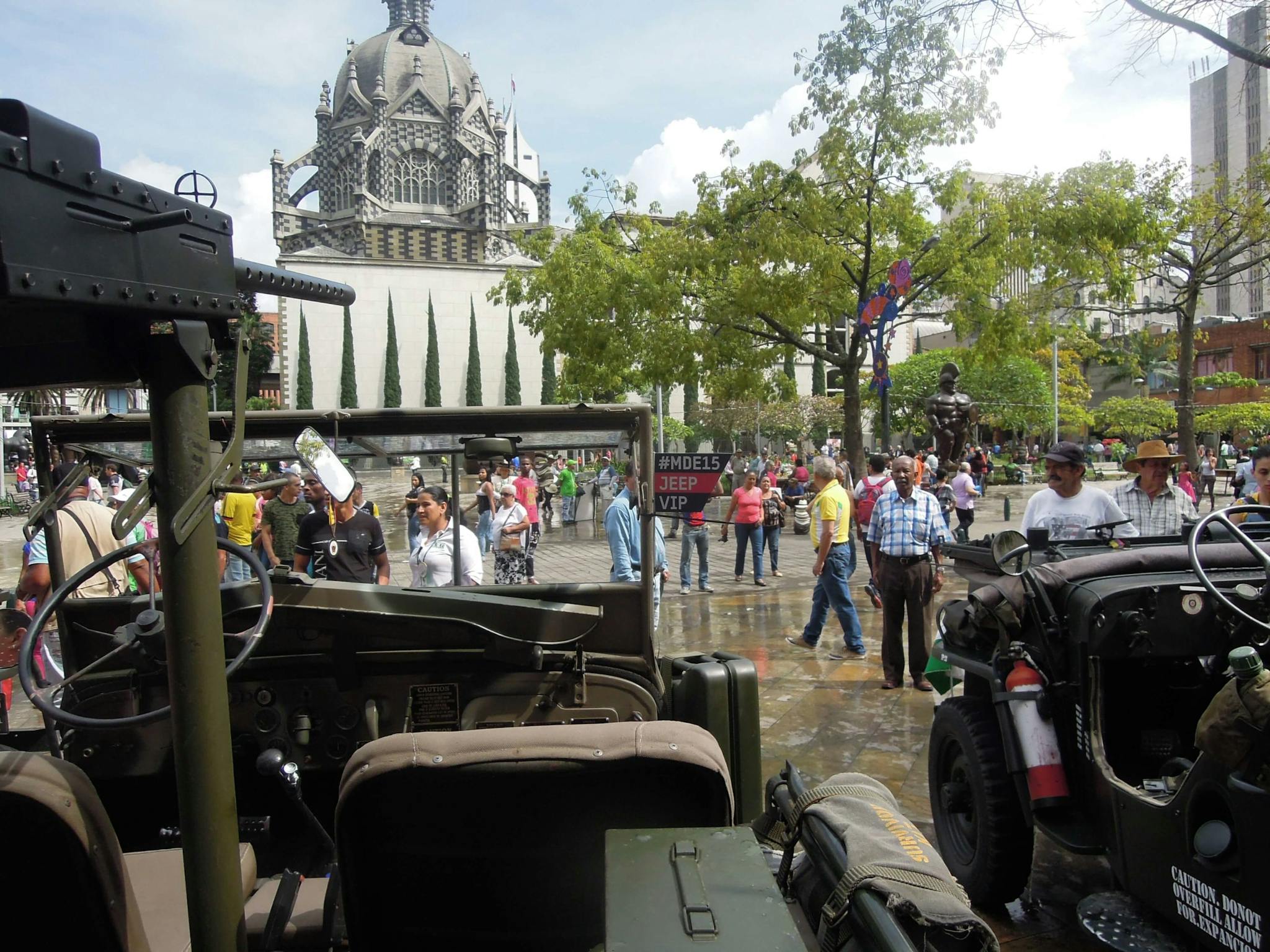
JO: “Jeep VIP” was commissioned for MDE (The Medellín International Art Encounter), a quadrennial city-wide exhibition that takes place in Medellín, Colombia. So, every four years the city dresses itself in art. For my participation in the exhibition I found this military Jeep club composed of almost ten middle-aged Colombian men. The club members all own Jeeps which they try to make look like American military war vehicles, with big machine guns on top, cases of bullets, grenades, and other guns on the side—all fake. When I started thinking about this phenomena, I couldn’t get it off of my head, thinking of it as an expression of the militaristic type of mindset installed in the Colombian psyche as a result of the failed US-backed war on drugs.
I orchestrated a performance taking place on the opening weekend of MDE in which four of those fake military Jeeps acted as the official VIP touring vehicles for the events all over the city. The original club members performed as the driver tour guides and the Jeeps sported MDE logos, while two mounted cameras behind the machine guns shot video in the style of a combat vehicle video game. Some of footage subsequently composed a video installation in the main exhibition.
IA: I wish I could have been there for that. It makes such a spectacle out of the subject—the contemporary art biennial [or quadrennial].
JO: That was part of the idea, yes. It was incredible to see all the reactions to the Jeeps. The first thing that people wanted was to jump on them and take pictures. But at its core, this work was about understanding the reality of globalization, as it was brought on by the war on drugs, in the context of an international art quadrennial. The jeeps were parked in front of the museum, in the most recognizable plaza in Medellín where you see this beautiful huge museum, the second-largest in the country, and it is basically guarded with four Jeeps with guns pointing at the coming public for an international art exhibition. Extreme poverty, gang violence, sexual tourism…most of these stories don’t make it to these art events in ways that engage with their immediate social mechanics. For MDE, my goal was to decontextualize a traditional, positive art world setting with uncomfortable moments that force people to question the complex role of art within them. I’m mostly interested in examining the open scars left by history, not as a way of reviving some type of trauma, but more as a way to understand where we are at today.
IA: It seems like a big way in which you do that is by creating interactive works—so that these nuanced, often uncanny experiences can heighten our more nuanced understanding of historical or contemporary situations. I like that you do this in ways that tread both light and dark, and always with a sense of humor. I’m thinking in particular of “The Snapp” from 2017 and “A Bird Without a Song” from 2016, both of which open the door for the public to critique certain norms—particularly related to social media and marketing—that we tend to subconsciously submit ourselves to. Can you start by talking about the action that you created with the Snapp app?

Juan Obando, The Snapp, app website screenshot, Boston, 2018. Courtesy of artist’s archive.
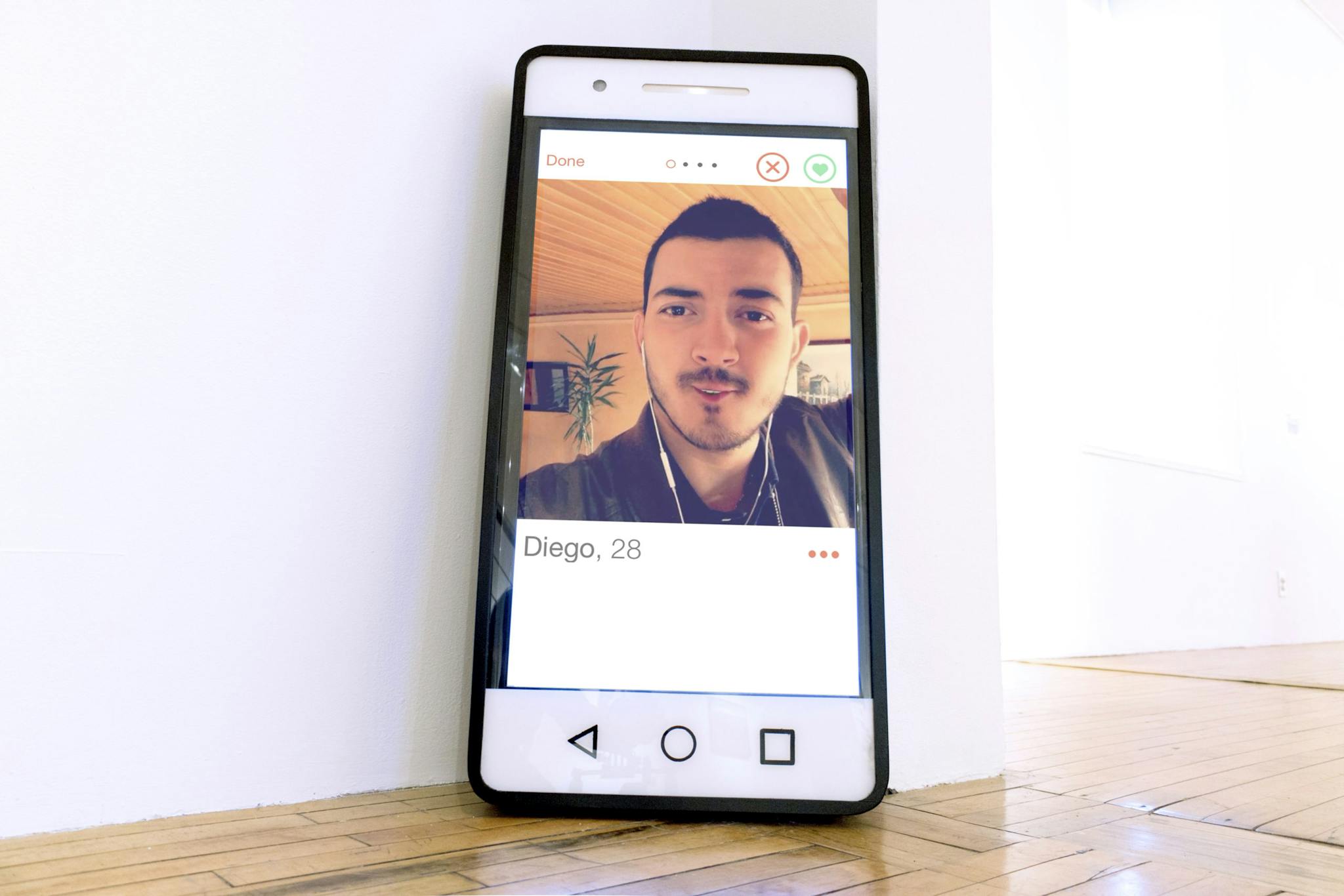
Juan Obando, A Bird Without A Song, installation view, MassArt, Boston, 2019. Courtesy of artist’s archive.
JO: “The Snapp” is a free-download mobile app that allows you to perform a digital finger-snap by just tapping your phone screen. It came about when I was suddenly immersed in the American academic world and became very curious by the use of snapping instead of clapping in many academic circuits. When researching about that phenomena, I came across an article in the “New York Times” that explained why “snapping is the new clapping.” One of the most fascinating reasons that the article gave was the influence of social media in real life human behavior: snapping as a real-life “like.” It also highlighted that snapping is something that you could do while holding a phone—as most of U.S. are either texting, taking photos, or scrolling, but also still listening to what somebody else is saying, which says so much about our multitasking capacities nowadays.
IA: Or of our lack of ability to focus…
JO: Yes! I was trying to do a positive spin on that…
IA: I know, you really were, I appreciate that.
JO: In Zen meditation practices there are these micro-poems called koans. One of the most famous ones is: “If a tree falls in the forest and no one is around to hear it, does it make a sound?” I was made aware of another—more humorous—koan that appears in The Simpsons that says: “What is the sound of one hand clapping?” I then imagined a more absurd question, “What is the sound of one finger snapping?” The answer came to me: “There’s an app for that!” So in The Snapp, there’s obviously an embedded comment on the dissonance between digital activism and the production process and privacy policies behind mobile devices, but I was really more interested in the digitalization of human gesturing and public performance—the way we use emojis, filters, and digital presence as extensions of our communal humanity.
IA: That’s interesting, even with sometimes absurd communication methods like emojis, these are still very real ways in which people communicate and create digital languages today.
JO: I was thinking about the laziest way to perform activism or to participate in a communal performance of agreement, from clapping to snapping to just tapping with one finger. At the same time, I was interested in staging a digital and physical interruption in which, instead of multitasking, while using the app you cannot use your phone for anything else but to “snap.” It embraces the language of digital media but at the same time it completely makes the phone useless because you’re now using all the power from this micro computer that you have in your pocket just for something as absurd as snapping.
IA: I love the humor involved in critiquing ingenuine social media activism—there is such an emphasis today on the importance of activism that I think it leads to a lot of posturing. At least, it does in the US.
JO: I think humor is so important—it’s a very sophisticated way of dealing with the public realities of a country like Colombia, for example. For me, humor has a power to really engage and implicate people. Once you have a reaction as visceral as laughing at something, you’re already taken by it. Of course there are works of art that make some people cry or experience panic, but humor has this very special place in our lexicon as a tool to create communality.
IA: So in talking about humor, let’s go back to “A Bird Without a Song.” I’m especially curious to hear what happened with the legal battle over that one Tinder user’s privacy rights…
JO: The idea formed when I came back to Colombia from 2013 to 2015 and was seeing the way people craved the latest American trends and consumed them even more intensely than audiences in the U.S. This phenomena appeared so symptomatic to me of the impact of neoliberal “free market” American policies on Colombia in the early ’90s, a time when American imports became highly valuable and a signifier for Colombia’s upper class—it identified people that had access to cable TV, bilingual education, and so on. So when the Internet came in, it completely changed the game because suddenly everybody had access. And when Tinder came in, it was a complete social revolution—my friends were actually using Tinder more intensively than most people in the US, and I was fascinated by this. It was very melancholic to me. I don’t know why, but after hours of swiping, I started singing Sinead
O’Connor’s “Nothing Compares 2 U” in my head.
I then proceeded to take screenshots of the profiles that I thought were the most representative of the kind of photographic tropes that you find on Tinder and animated them to look like they were singing “Nothing Compares 2 U.” I decided to make it into a video sculpture in the form of a giant phone. This format made sense, as it amplifies the naive thought that our digital footprint can be private—it’s not.
IA: We all know we sign away all our privacy rights when we quick-scroll through the terms and agreement section of any app and check “I agree.” It’s assumed all our content becomes available at that point.
JO: Well, when this piece was shown at the Museum of Modern Art in Medellín in 2018, I started to get calls from the curator of the show about an Instagram post. Turns out that the museum had posted a photo of the piece which was taken at a point in the video where this one Tinder user shows up. Somehow, this person showed up on their comments threatening to sue the museum, denouncing invasion of his privacy. This led to the museum taking down the post and—in my view—missing an educational opportunity to engage with its public about the very problems that the piece highlights. It’s so ironic how companies such as Tinder and Instagram capitalize themselves exponentially by collecting and trafficking the information we happily give them, while we, as users and as the public, still don’t know where to direct our frustration with the conditions of self-exploitation and post-privacy to which we are exposed.
IA: Maybe this was why Twitter was created—the digital outlet to opine and frustratedly rant! We could keep talking about so many of your projects that fit within this issue, but I’m going to ask just one more question: Did you ever go on a Tinder date during all that swiping?
JO: You know, I was already in a relationship then…otherwise I would have!
Juan Obando’s “Pro Revolution Soccer” will be on view in “Game Changers: Video Games & Contemporary Art” from February 22nd through April 19th at the Mass Art Art Museum, 621 Huntington Ave, Boston, MA 02115.
